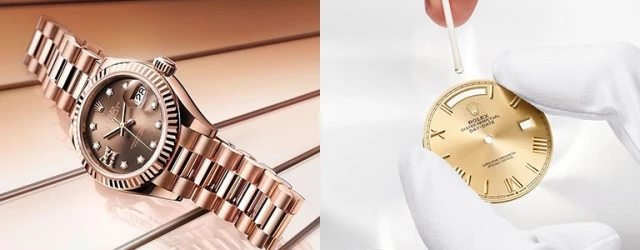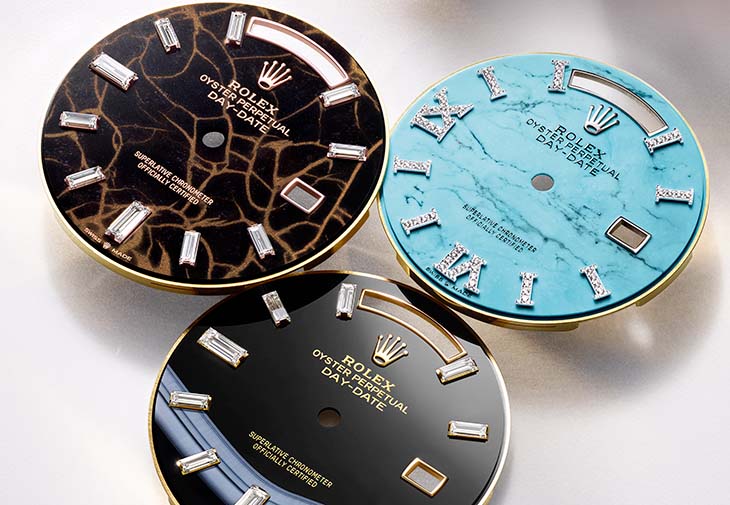Introduction
Rolex, a name synonymous with precision, luxury, and innovation, has earned its reputation as the world’s most prestigious watchmaker. Behind each Rolex timepiece lies a combination of advanced technology, skilled craftsmanship, and an unwavering commitment to perfection. The process of creating a Rolex watch is nothing short of a marvel, with each component meticulously engineered and hand-assembled to achieve the highest standards of quality and performance.
This article delves into the detailed process and cutting-edge technologies that power Rolex’s iconic watches, from the creation of its proprietary movements to the production of its signature Oyster cases. We will explore how Rolex balances traditional craftsmanship with modern technology to create timepieces that are not only beautiful but also reliable and innovative.
Chapter 1: Rolex’s Commitment to Quality and Innovation
1.1 The Rolex Philosophy: Excellence at Every Step
Rolex’s philosophy has always been grounded in quality, precision, and innovation. This philosophy is embedded in every aspect of the design, development, and manufacturing of a Rolex watch. The brand’s commitment to excellence ensures that every watch that leaves its production facility meets the highest standards in the watchmaking industry.
Rolex’s manufacturing process is vertically integrated, meaning that the company controls virtually every step of the watch production process, from smelting its own metals to creating and assembling the movement, case, bracelet, and even the final packaging. This level of control allows Rolex to maintain its legendary standards of quality and precision.
1.2 Innovation and Research & Development
Rolex has always been at the forefront of innovation in watchmaking, consistently pushing the boundaries of what is possible with new materials, techniques, and technologies. The company invests heavily in research and development (R&D) to ensure that its watches continue to perform at the highest levels and incorporate cutting-edge technology.
Notable technological innovations from Rolex include the creation of the Oyster case, the first waterproof watch case; the Perpetual rotor, which revolutionized automatic movements; and the use of advanced materials such as Cerachrom and 904L stainless steel for superior durability and corrosion resistance.
Chapter 2: The Rolex Manufacturing Process
2.1 The Role of Vertical Integration
Rolex’s commitment to producing the finest watches in the world is reflected in its fully integrated production process. Unlike many other luxury watchmakers who rely on third-party suppliers for certain components, Rolex manufactures nearly every part of its watches in-house. This includes not only the movement but also the cases, bracelets, dials, and even the oils used in the movements.
Rolex’s factory, known as the Rolex Manufacturing Complex, is one of the most advanced watchmaking facilities in the world. Located in Biel/Bienne, Switzerland, it is equipped with state-of-the-art machinery that works in tandem with the expertise of its highly skilled watchmakers. By producing nearly all of its components internally, Rolex ensures that every watch meets its exacting standards.
2.2 The Oyster Case – A Triumph of Engineering
One of the most iconic elements of Rolex watches is the Oyster case, which has become synonymous with durability and water resistance. The Oyster case was the first waterproof wristwatch case, introduced in 1926, and it has become a hallmark of Rolex’s commitment to technical innovation.
- Material Selection: Rolex uses only the finest materials for its cases. Its signature Oystersteel, an alloy made from 904L stainless steel, is highly resistant to corrosion, ensuring that the watch remains pristine even in harsh environments. The use of 18k gold and platinum for select models further emphasizes Rolex’s commitment to quality and luxury.
- Case Construction: The Oyster case is made through a multi-step process that includes stamping, milling, and polishing. It is designed with a screw-down back, a screw-down winding crown, and a hermetically sealed case, all of which work together to make the watch waterproof to significant depths, depending on the model.
- Water Resistance: Rolex watches are rigorously tested for water resistance. Each Oyster case is subjected to a series of tests, including pressure tests in water tanks, to ensure that it can withstand extreme conditions.
2.3 The Movement – The Heart of Rolex Watches
The movement, or caliber, is the most complex and vital part of any Rolex watch. Rolex is renowned for designing and manufacturing its own movements, ensuring the highest level of precision and reliability.
- The Perpetual Rotor: Rolex revolutionized automatic watch technology with the invention of the Perpetual rotor in 1931. This self-winding mechanism utilizes the natural motion of the wearer’s wrist to wind the mainspring, providing a constant source of energy for the watch. The Perpetual rotor is at the heart of all Rolex automatic movements.
- The Caliber Movement: Rolex’s movements are developed entirely in-house, with each one receiving rigorous testing to ensure its accuracy and durability. The brand’s calibers, such as the 3135 and 3235, feature innovations like a Chronergy escapement for greater efficiency and improved power reserves.
- Chronometer Certification: Rolex watches are known for their exceptional accuracy. All Rolex movements are tested and certified as chronometers by the Swiss Official Chronometer Testing Institute (COSC), ensuring that they perform within the strictest standards of timekeeping accuracy.
- The Power Reserve: Modern Rolex movements offer impressive power reserves, with many models capable of running for 48 to 72 hours without requiring winding. This is a direct result of Rolex’s precision engineering and the energy efficiency of the Perpetual rotor.
Chapter 3: Advanced Materials and Technological Innovation
3.1 Use of Innovative Materials in Rolex Watches
Rolex has long been at the forefront of using innovative materials that enhance the performance, durability, and aesthetic quality of its timepieces. The brand’s commitment to innovation is evident in its use of proprietary alloys and materials in its watches.
- 904L Stainless Steel (Oystersteel): Rolex’s decision to use 904L stainless steel, an alloy known for its superior resistance to corrosion, was a bold one. Oystersteel is much more resistant to oxidation and wear than the more commonly used 316L stainless steel. This material is particularly resistant to saltwater, making it ideal for Rolex’s dive watches such as the Submariner.
- Cerachrom Bezel Insert: Rolex’s patented Cerachrom ceramic bezel insert is highly scratch-resistant and virtually impervious to fading. It is used on models like the Submariner and GMT-Master II, ensuring that the bezel retains its pristine appearance even after prolonged exposure to harsh conditions.
- Rolesor and 18k Gold: For its precious metal watches, Rolex uses a combination of stainless steel and 18k gold (called Rolesor), or uses solid 18k gold or platinum for the entire watch. The use of these metals, carefully crafted and polished, gives Rolex watches their signature luxury feel and look.
- Parachrom Hairspring: To further improve the precision and durability of its movements, Rolex has developed the Parachrom hairspring, which is made from a special alloy that is highly resistant to magnetic fields, shocks, and temperature changes. This helps ensure that the watch’s timekeeping remains accurate under extreme conditions.
3.2 Rolex’s Advanced Watchmaking Techniques
Rolex’s commitment to technology and innovation is also reflected in the company’s watchmaking techniques. The company’s engineers and watchmakers utilize cutting-edge technology to perfect every component.
- CNC Machining: Rolex employs computer numerical control (CNC) machines to precisely mill and shape parts of the movement and case. This ensures that the tolerances are incredibly tight, with components fitting together perfectly.
- Microstella Regulator: The Microstella regulator is a unique Rolex innovation that allows for precise regulation of the balance wheel, further enhancing the accuracy of the movement. It’s a testament to the brand’s obsession with precision.
- Laser Welding: Rolex uses laser welding technology to join materials without causing any deformation or damage to the surrounding areas. This technique is particularly important in creating flawless joints and maintaining the integrity of the watch’s structure.
- Hand-finishing: Despite the use of advanced machinery, Rolex watches are also hand-finished by highly skilled artisans. Each watch is inspected and polished by hand to ensure that it meets the company’s aesthetic standards. The hand-finishing process includes polishing the movement components, the case, and the bracelet to perfection.

Chapter 4: Rolex Testing and Quality Control
4.1 Rigorous Testing of Every Rolex Watch
Rolex is known for its rigorous testing and quality control procedures. Each watch undergoes a series of extensive tests to ensure it meets the brand’s exacting standards.
- COSC Chronometer Certification: All Rolex watches are certified as chronometers by the Swiss Official Chronometer Testing Institute (COSC). To achieve this certification, a watch must meet strict accuracy requirements, with an average daily variation of no more than -4 to +6 seconds.
- Water Resistance Testing: Every Rolex watch with a water-resistant case is subjected to pressure tests to ensure that it can withstand the specified depth of water resistance. These tests are performed using specialized equipment to simulate extreme underwater conditions.
- Movement Testing: Rolex movements are put through several tests to ensure that they operate smoothly and maintain accuracy over time. This includes testing
the movement’s resistance to temperature fluctuations, shocks, and magnetic fields.
- Final Quality Control: Once the watch has passed all of these tests, it undergoes a final inspection to ensure that it meets Rolex’s high standards for both functionality and aesthetics. Every detail, from the alignment of the hands to the finishing of the bracelet, is carefully examined before the watch is deemed ready for sale.
Chapter 5: Rolex’s Legacy of Precision, Durability, and Innovation
5.1 The Evolution of Rolex Watches
From the introduction of the Oyster case to the development of groundbreaking movements and materials, Rolex has consistently led the way in innovation. The brand’s watches are not just products—they are the result of decades of research, craftsmanship, and refinement.
5.2 Rolex in the Future – Continuing the Tradition of Innovation
Rolex’s commitment to maintaining its position at the cutting edge of horology ensures that the brand will continue to shape the future of watchmaking. With its focus on quality, precision, and durability, Rolex is poised to remain the undisputed leader in luxury watches for years to come.
Conclusion: A Perfect Marriage of Tradition and Technology
The Rolex manufacturing process is a testament to the brand’s dedication to excellence and its ability to blend traditional watchmaking techniques with cutting-edge technology. Every Rolex watch is the result of years of innovation, craftsmanship, and a relentless pursuit of perfection. It is this combination of precision engineering and timeless craftsmanship that has made Rolex the most respected and admired name in the watchmaking world.
As the brand continues to evolve, its commitment to quality and innovation ensures that Rolex watches will remain at the pinnacle of horological achievement, admired for both their beauty and their technical superiority.





































